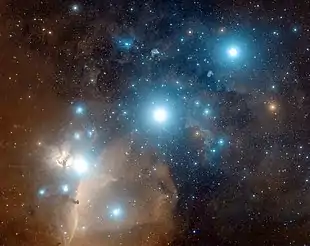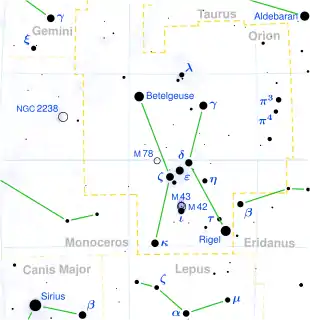Alnilam
Alnilam /ælˈnaɪlæm/,[9] designation ε Orionis, (Latinized to Epsilon Orionis, abbreviated Epsilon Ori, ε Ori) and 46 Orionis (46 Ori), is a large blue supergiant star some 2,000 light-years distant in the constellation of Orion. It is estimated to be 275,000 to 832,000 times as luminous as the Sun, and 30–64.5 times as massive.
| Observation data Epoch J2000 Equinox J2000 | |
|---|---|
| Constellation | Orion |
| Right ascension | 05h 36m 12.8s[1] |
| Declination | −01° 12′ 06.9″[1] |
| Apparent magnitude (V) | 1.69[2] (1.64 – 1.74[3]) |
| Characteristics | |
| Spectral type | B0 Ia[4] |
| U−B color index | −1.03[2] |
| B−V color index | −0.18[2] |
| Variable type | α Cygni[3] |
| Astrometry | |
| Radial velocity (Rv) | 25.9[5] km/s |
| Proper motion (μ) | RA: 1.49[1] mas/yr Dec.: −1.06[1] mas/yr |
| Parallax (π) | 1.65 ± 0.45[1] mas |
| Distance | approx. 2,000 ly (approx. 600 pc) |
| Absolute magnitude (MV) | −6.89[6] |
| Details | |
| Mass | 30 - 64.5[7] M☉ |
| Radius | 32.4[6] R☉ |
| Luminosity | 537,000[6] L☉ |
| Surface gravity (log g) | 3.0[7] cgs |
| Temperature | 27,500±100[6] K |
| Rotational velocity (v sin i) | 40–70[7] km/s |
| Age | 5.7[8] Myr |
| Other designations | |
| Database references | |
| SIMBAD | data |
Observation

It is the 29th-brightest star in the sky (the 4th-brightest in Orion) and is a blue supergiant. Together with Mintaka and Alnitak, the three stars make up Orion's belt, known by many names across many ancient cultures. Alnilam is the middle star. It is slightly variable, from magnitude 1.64 to 1.74.[10] Since 1943, the spectrum of this star has served as one of the stable anchor points by which other stars are classified.[4] It is also one of the 58 stars used in celestial navigation. It is at its highest point in the sky around midnight on December 15.
Physical characteristics
Estimates of Alnilam's properties vary. Crowther and colleagues, using stellar wind and atmospheric modelling in 2006, came up with a luminosity 275,000 times that of the Sun (L☉), and effective temperature of 27,000 K and a radius 24 times that of the Sun (R☉).[11] Searle and colleagues, using CMFGEN code to analyse the spectrum in 2008, calculated a luminosity of 537,000 L☉, an effective temperature of 27,500 ± 100 K and a radius of 32.4 ± 0.75 R☉.[6] Analysis of the spectra and age of the members of the Orion OB1 association yields a mass 34.6 times that of the Sun (40.8 M☉ on the main sequence) and an age of 5.7 million years.[8]
A more recent detailed analysis of Alnilam across multiple wavelength bands produced very high luminosity, radius, and mass estimates, assuming the distance of 606 parsecs suggested by the Hipparcos new reduction.[1] Adopting the larger parallax from the original Hipparcos reduction gives a distance of 412 parsecs[12] and physical parameters more consistent with earlier publications. The luminosity of 832,000 L☉ at 606 parsecs is the highest ever derived for this star.[7]
Alnilam's relatively simple spectrum has made it useful for studying the interstellar medium. Within the next million years, this star may turn into a red supergiant and explode as a supernova. It is surrounded by a molecular cloud, NGC 1990, which it illuminates to make a reflection nebula. Its stellar winds may reach up to 2000 km/s, causing it to lose mass about 20 million times more rapidly than the Sun.[11]
Nomenclature and history
ε Orionis is the star's Bayer designation and 46 Orionis its Flamsteed designation.
The traditional name Alnilam derives from the Arabic النظام al-niẓām 'arrangement/string (of pearls)'. Related spellings are Alnihan and Alnitam:[13] all three variants are evidently mistakes in transliteration or copy errors, the first perhaps due to confusion with النيلم al-nilam 'sapphire'.[14] In 2016, the International Astronomical Union organized a Working Group on Star Names (WGSN)[15] to catalog and standardize proper names for stars. The WGSN's first bulletin of July 2016[16] included a table of the first two batches of names approved by the WGSN; which included Alnilam for this star. It is now so entered in the IAU Catalog of Star Names.[17]
Orion's Belt
The three belt stars were collectively known by many names in many cultures. Arabic terms include Al Nijād 'the Belt', Al Nasak 'the Line', Al Alkāt 'the Golden Grains or Nuts', and, in modern Arabic, Al Mīzān al H•akk 'the Accurate Scale Beam'. In Chinese mythology, they were also known as The Weighing Beam.[13]
In Chinese, 參宿 (Shēn Sù), meaning Three Stars (asterism), refers to an asterism consisting of Alnilam, Alnitak, and Mintaka (Orion's Belt), with Betelgeuse, Bellatrix, Saiph, and Rigel later added.[18] Consequently, the Chinese name for Alnilam is 參宿二 (Shēn Sù èr, English: the Second Star of Three Stars).[19] It is one of the western mansions of the White Tiger.
See also
References
- van Leeuwen, F. (November 2007). "Validation of the new Hipparcos reduction". Astronomy & Astrophysics. 474 (2): 653–664. arXiv:0708.1752. Bibcode:2007A&A...474..653V. doi:10.1051/0004-6361:20078357. S2CID 18759600.
- Ducati, J. R. (2002). "VizieR Online Data Catalog: Catalogue of Stellar Photometry in Johnson's 11-color system". CDS/ADC Collection of Electronic Catalogues. 2237. Bibcode:2002yCat.2237....0D.
- Ruban, E. V.; Alekseeva, G. A.; Arkharov, A. A.; Hagen-Thorn, E. I.; Galkin, V. D.; Nikanorova, I. N.; Novikov, V. V.; Pakhomov, V. P.; Puzakova, T. Yu. (September 2006). "Spectrophotometric observations of variable stars". Astronomy Letters. 32 (9): 604–607. Bibcode:2006AstL...32..604R. doi:10.1134/S1063773706090052. S2CID 121747360.
- Morgan, W. W.; Keenan, Philip C.; Kellman, Edith (1943). "An Atlas of Stellar Spectra" (PDF). Astrophysical Monographs. 152 (3849): 147. Bibcode:1943Natur.152..147.. doi:10.1038/152147a0. S2CID 4109100.
- Gontcharov, G. A. (November 2006). "Pulkovo Compilation of Radial Velocities for 35 495 Hipparcos stars in a common system". Astronomy Letters. 32 (11): 759–771. arXiv:1606.08053. Bibcode:2006AstL...32..759G. doi:10.1134/S1063773706110065. S2CID 119231169.
- Searle, S. C.; Prinja, R. K.; Massa, D.; Ryans, R. (2008). "Quantitative studies of the optical and UV spectra of Galactic early B supergiants. I. Fundamental parameters". Astronomy and Astrophysics. 481 (3): 777–97. arXiv:0801.4289. Bibcode:2008A&A...481..777S. doi:10.1051/0004-6361:20077125. S2CID 1552752.
- Puebla, R.E.; Hillier, D.J.; Zsargó, J.; Cohen, D.H.; Leutenegger, M.A. (2015). "X-ray, UV and optical analysis of supergiants: ϵ Ori". Astronomy & Astrophysics. 456 (3): 2907–2936. arXiv:1511.09365. Bibcode:2016MNRAS.456.2907P. doi:10.1093/mnras/stv2783. S2CID 7887625.
- Voss, R.; Diehl, R.; Vink, J. S.; Hartmann, D. H. (2010). "Probing the evolving massive star population in Orion with kinematic and radioactive tracers". Astronomy and Astrophysics. 520: 10. arXiv:1005.3827. Bibcode:2010A&A...520A..51V. doi:10.1051/0004-6361/201014408. S2CID 38599952. A51.
- Kunitzsch, Paul; Smart, Tim (2006). A Dictionary of Modern star Names: A Short Guide to 254 Star Names and Their Derivations (2nd rev. ed.). Cambridge, Massachusetts: Sky Pub. ISBN 978-1-931559-44-7.
- "GCVS Query forms". www.sai.msu.su. Retrieved 2019-01-12.
- Crowther, P. A.; Lennon, D. J.; Walborn, N. R. (January 2006). "Physical parameters and wind properties of galactic early B supergiants". Astronomy & Astrophysics. 446 (1): 279–293. arXiv:astro-ph/0509436. Bibcode:2006A&A...446..279C. doi:10.1051/0004-6361:20053685. S2CID 18815761.
- Perryman, M. A. C.; Lindegren, L.; Kovalevsky, J.; Hoeg, E.; Bastian, U.; Bernacca, P. L.; Crézé, M.; Donati, F.; Grenon, M.; Grewing, M.; Van Leeuwen, F.; Van Der Marel, H.; Mignard, F.; Murray, C. A.; Le Poole, R. S.; Schrijver, H.; Turon, C.; Arenou, F.; Froeschlé, M.; Petersen, C. S. (1997). "The HIPPARCOS Catalogue". Astronomy and Astrophysics. 323: L49. Bibcode:1997A&A...323L..49P.
- Allen, Richard Hinckley (1936). Star-names and their meanings. pp. 314–315.
- Knobel, E. B. (September 1909). "The name of epsilon Orionis". The Observatory. 32: 357. Bibcode:1909Obs....32..357K.
- "IAU Working Group on Star Names (WGSN)". Retrieved 22 May 2016.
- "Bulletin of the IAU Working Group on Star Names, No. 1" (PDF). Retrieved 28 July 2016.
- "IAU Catalog of Star Names". Retrieved 28 July 2016.
- (in Chinese) 中國星座神話, written by 陳久金. Published by 台灣書房出版有限公司, 2005, ISBN 978-986-7332-25-7.
- (in Chinese) AEEA (Activities of Exhibition and Education in Astronomy) 天文教育資訊網 2006 年 5 月 25 日

